标签:决定 before htm queue 不同 工作 for equal active
Linux系统一般有4个主要部分:内核、shell、文件系统和应用程序。内核、shell和文件系统一起形成了基本的操作系统结构,它们使得用户可以运行程序、管理文件并使用系统。
(1)内核
内核是操作系统的核心,具有很多最基本功能,如虚拟内存、多任务、共享库、需求加载、可执行程序和TCP/IP网络功能。Linux内核的模块分为以下几个部分:存储管理、CPU和进程管理、文件系统、设备管理和驱动、网络通信、系统的初始化和系统调用等。
(2)shell
shell是系统的用户界面,提供了用户与内核进行交互操作的一种接口。它接收用户输入的命令并把它送入内核去执行,是一个命令解释器。另外,shell编程语言具有普通编程语言的很多特点,用这种编程语言编写的shell程序与其他应用程序具有同样的效果。
(3)文件系统
文件系统是文件存放在磁盘等存储设备上的组织方法。Linux系统能支持多种目前流行的文件系统,如EXT2、EXT3、FAT、FAT32、VFAT和ISO9660。
(4)应用程序
标准的Linux系统一般都有一套都有称为应用程序的程序集,它包括文本编辑器、编程语言、XWindow、办公套件、Internet工具和数据库等。
(1)什么是进程
进程是处于执行期的程序以及它所包含的所有资源的总称,包括虚拟处理器,虚拟空间,寄存器,堆栈,全局数据段等。
在Linux中,每个进程在创建时都会被分配一个数据结构,称为进程控制(Process Control Block,简称PCB)。PCB中包含了很多重要的信息,供系统调度和进程本身执行使用。所有进程的PCB都存放在内核空间中。PCB中最重要的信息就是进程PID,内核通过这个PID来唯一标识一个进程。PID可以循环使用,最大值是32768。init进程的pid为1,其他进程都是init进程的后代。
除了进程控制块(PCB)以外,每个进程都有独立的内核堆栈(8k),一个进程描述符结构,这些数据都作为进程的控制信息储存在内核空间中;而进程的用户空间主要存储代码和数据。
查看进程:
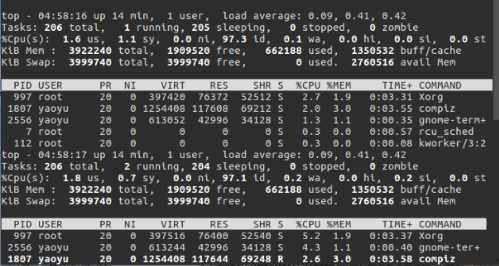
(2)进程创建
进程是通过调用::fork(),::vfork()【只复制task_struct和内核堆栈,所以生成的只是父进程的一个线程(无独立的用户空间)。】和::clone()【功能强大,带了许多参数。::clone()可以让你有选择性的继承父进程的资源,既可以选择像::vfork()一样和父进程共享一个虚拟空间,从而使创造的是线程,你也可以不和父进程共享,你甚至可以选择创造出来的进程和父进程不再是父子关系,而是兄弟关系。】系统调用创建新进程。在内核中,它们都是调用do_fork实现的。传统的fork函数直接把父进程的所有资源复制给子进程。而Linux的::fork()使用写时拷贝页实现,也就是说,父进程和子进程共享同一个资源拷贝,只有当数据发生改变时,数据才会发生复制。通常的情况,子进程创建后会立即调用exec(),这样就避免复制父进程的全部资源。
#fork():父进程的所有数据结构都会复制一份给子进程(写时拷贝页)。当执行fork()函数后,会生成一个子进程,子进程的执行从fork()的返回值开始,且代码继续往下执行
以下代码中,使用fork()创建了一个子进程。返回值pId有两个作用:一是判断fork()是否正常执行;二是判断fork()正常执行后如何区分父子进程。
1 #代码示例: 2 #include <stdio.h> 3 #include <stdlib.h> 4 #include <unistd.h> 5 6 int main (int argc, char ** argv) { 7 int flag = 0; 8 pid_t pId = fork(); 9 if (pId == -1) { 10 perror("fork error"); 11 exit(EXIT_FAILURE); 12 } else if (pId == 0) { 13 int myPid = getpid(); 14 int parentPid = getppid(); 15 16 printf("Child:SelfID=%d ParentID=%d \n", myPid, parentPid); 17 flag = 123; 18 printf("Child:flag=%d %p \n", flag, &flag); 19 int count = 0; 20 do { 21 count++; 22 sleep(1); 23 printf("Child count=%d \n", count); 24 if (count >= 5) { 25 break; 26 } 27 } while (1); 28 return EXIT_SUCCESS; 29 } else { 30 printf("Parent:SelfID=%d MyChildPID=%d \n", getpid(), pId); 31 flag = 456; 32 printf("Parent:flag=%d %p \n", flag, &flag); // 连地址都一样,说明是真的完全拷贝,但值已经是不同的了.. 33 int count = 0; 34 do { 35 count++; 36 sleep(1); 37 printf("Parent count=%d \n", count); 38 if (count >= 2) { 39 break; 40 } 41 } while (1); 42 } 43 44 return EXIT_SUCCESS; 45 }
(3)进程撤销
进程通过调用exit()退出执行,这个函数会终结进程并释放所有的资源。父进程可以通过wait4()查询子进程是否终结。进程退出执行后处于僵死状态,直到它的父进程调用wait()或者waitpid()为止。父进程退出时,内核会指定线程组的其他进程或者init进程作为其子进程的新父进程。当进程接收到一个不能处理或忽视的信号时,或当在内核态产生一个不可恢复的CPU异常而内核此时正代表该进程在运行,内核可以强迫进程终止。
(4)进程管理
内核把进程信息存放在叫做任务队列(task list)的双向循环链表中(内核空间)。链表中的每一项都是类型为task_struct,称为进程描述符结构(process descriptor),包含了一个具体进程的所有信息,包括打开的文件,进程的地址空间,挂起的信号,进程的状态等。

Linux通过slab分配器分配task_struct,这样能达到对象复用和缓存着色(通过预先分配和重复使用task_struct,可以避免动态分配和释放所带来的资源消耗)。
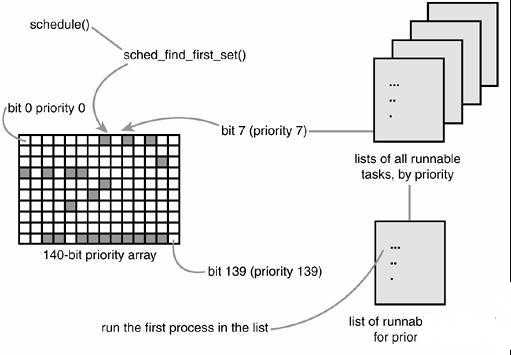
struct task_struct { volatile long state; pid_t pid; unsigned long timestamp; unsigned long rt_priority; struct mm_struct *mm, *active_mm }
对于向下增长的栈来说,只需要在栈底(对于向上增长的栈则在栈顶)创建一个新的结构struct thread_info,使得在汇编代码中计算其偏移量变得容易。
#在x86上,thread_info结构在文件<asm/thread_info.h>中定义如下:
struct thread_info{ struct task_struct *任务 struct exec_domain *exec_domain; unsigned long flags; unsigned long status; __u32 cpu; __s32 preempt_count; mm_segment_t addr_limit; struct restart_block restart_block; unsigned long previous_esp; _u8 supervisor_stack[0]; };
内核把所有处于TASK_RUNNING状态的进程组织成一个可运行双向循环队列。调度函数通过扫描整个可运行队列,取得最值得执行的进程投入执行。避免扫描所有进程,提高调度效率。
#进程调度使用schedule()函数来完成,下面我们从分析该函数开始,代码如下: 1 asmlinkage __visible void __sched schedule(void) 2 { 3 struct task_struct *tsk = current; 4 5 sched_submit_work(tsk); 6 __schedule(); 7 } 8 EXPORT_SYMBOL(schedule);
#在第4段进程调度中将具体讲述功能实现
(5)进程内核堆栈
Linux为每个进程分配一个8KB大小的内存区域,用于存放该进程两个不同的数据结构:thread_info和进程的内核堆栈。
进程处于内核态时使用不同于用户态堆栈,内核控制路径所用的堆栈很少,因此对栈和描述符来说,8KB足够了。
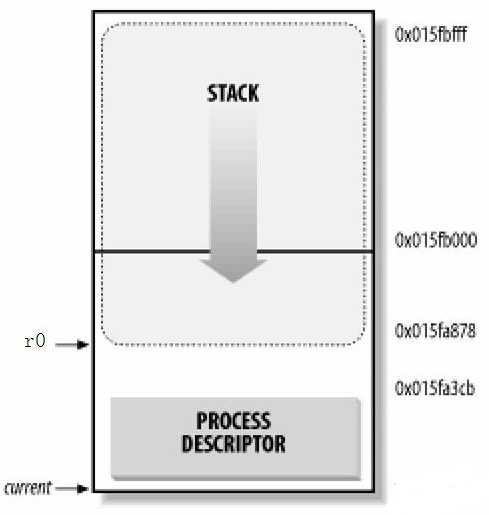
有以下进程状态:
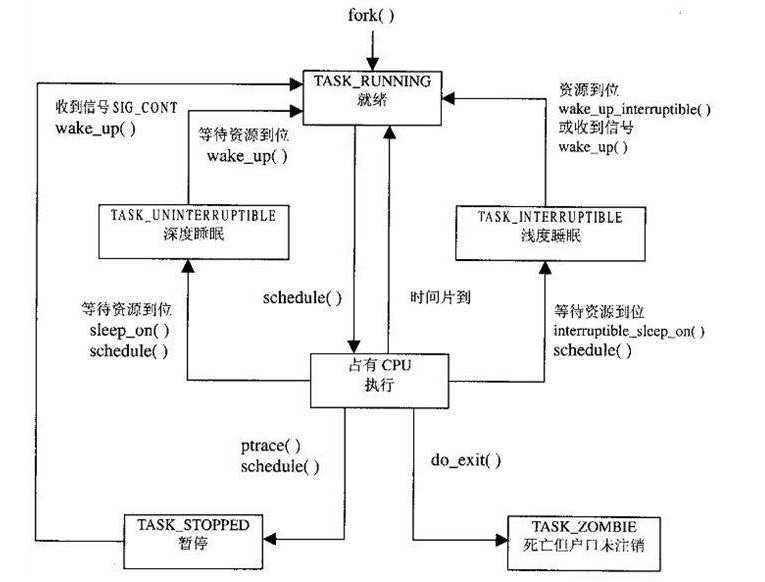
进程状态的转换:
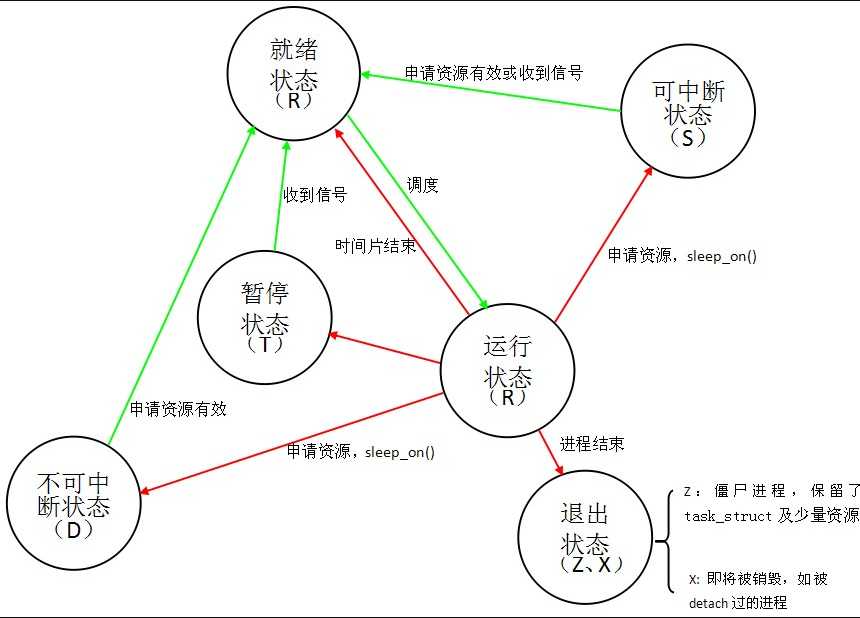
具体转换分析:
(1)进程的初始状态
进程是通过fork系列的系统调用(fork、clone、vfork)来创建的,内核(或内核模块)也可以通过kernel_thread函数创建内核进程。这些创建子进程的函数本质上都完成了相同的功能——将调用进程复制一份,得到子进程。(可以通过选项参数来决定各种资源是共享、还是私有。)那么既然调用进程处于TASK_RUNNING状态(否则,它若不是正在运行,又怎么进行调用?),则子进程默认也处于TASK_RUNNING状态。另外,在系统调用调用clone和内核函数kernel_thread也接受CLONE_STOPPED选项,从而将子进程的初始状态置为 TASK_STOPPED。
(2)进程状态变迁
进程自创建以后,状态可能发生一系列的变化,直到进程退出。而尽管进程状态有好几种,但是进程状态的变迁却只有两个方向——从TASK_RUNNING状态变为非TASK_RUNNING状态、或者从非TASK_RUNNING状态变为TASK_RUNNING状态。也就是说,如果给一个TASK_INTERRUPTIBLE状态的进程发送SIGKILL信号,这个进程将先被唤醒(进入 TASK_RUNNING状态),然后再响应SIGKILL信号而退出(变为TASK_DEAD状态)。并不会从TASK_INTERRUPTIBLE状态直接退出。进程从非TASK_RUNNING状态变为TASK_RUNNING状态,是由别的进程(也可能是中断处理程序)执行唤醒操作来实现的。执行唤醒的进程设置被唤醒进程的状态为TASK_RUNNING,然后将其task_struct结构加入到某个CPU的可执行队列中。于是被唤醒的进程将有机会被调度执行。
而进程从TASK_RUNNING状态变为非TASK_RUNNING状态,则有两种途径:
毋庸置疑,我们使用schedule()函数来完成进程调度,接下来就来看看进程调度的代码以及实现过程吧。
1 asmlinkage __visible void __sched schedule(void) 2 { 3 struct task_struct *tsk = current; 4 5 sched_submit_work(tsk); 6 __schedule(); 7 } 8 EXPORT_SYMBOL(schedule);
第3行获取当前进程描述符指针,存放在本地变量tsk中。第6行调用__schedule(),代码如下(kernel/sched/core.c):

1 static void __sched __schedule(void) 2 { 3 struct task_struct *prev, *next; 4 unsigned long *switch_count; 5 struct rq *rq; 6 int cpu; 7 8 need_resched: 9 preempt_disable(); 10 cpu = smp_processor_id(); 11 rq = cpu_rq(cpu); 12 rcu_note_context_switch(cpu); 13 prev = rq->curr; 14 15 schedule_debug(prev); 16 17 if (sched_feat(HRTICK)) 18 hrtick_clear(rq); 19 20 /* 21 * Make sure that signal_pending_state()->signal_pending() below 22 * can‘t be reordered with __set_current_state(TASK_INTERRUPTIBLE) 23 * done by the caller to avoid the race with signal_wake_up(). 24 */ 25 smp_mb__before_spinlock(); 26 raw_spin_lock_irq(&rq->lock); 27 28 switch_count = &prev->nivcsw; 29 if (prev->state && !(preempt_count() & PREEMPT_ACTIVE)) { 30 if (unlikely(signal_pending_state(prev->state, prev))) { 31 prev->state = TASK_RUNNING; 32 } else { 33 deactivate_task(rq, prev, DEQUEUE_SLEEP); 34 prev->on_rq = 0; 35 36 /* 37 * If a worker went to sleep, notify and ask workqueue 38 * whether it wants to wake up a task to maintain 39 * concurrency. 40 */ 41 if (prev->flags & PF_WQ_WORKER) { 42 struct task_struct *to_wakeup; 43 44 to_wakeup = wq_worker_sleeping(prev, cpu); 45 if (to_wakeup) 46 try_to_wake_up_local(to_wakeup); 47 } 48 } 49 switch_count = &prev->nvcsw; 50 } 51 52 if (prev->on_rq || rq->skip_clock_update < 0) 53 update_rq_clock(rq); 54 55 next = pick_next_task(rq, prev); 56 clear_tsk_need_resched(prev); 57 clear_preempt_need_resched(); 58 rq->skip_clock_update = 0; 59 60 if (likely(prev != next)) { 61 rq->nr_switches++; 62 rq->curr = next; 63 ++*switch_count; 64 65 context_switch(rq, prev, next); /* unlocks the rq */ 66 /* 67 * The context switch have flipped the stack from under us 68 * and restored the local variables which were saved when 69 * this task called schedule() in the past. prev == current 70 * is still correct, but it can be moved to another cpu/rq. 71 */ 72 cpu = smp_processor_id(); 73 rq = cpu_rq(cpu); 74 } else 75 raw_spin_unlock_irq(&rq->lock); 76 77 post_schedule(rq); 78 79 sched_preempt_enable_no_resched(); 80 if (need_resched()) 81 goto need_resched; 82 }
第9行禁止内核抢占。第10行获取当前的cpu号。第11行获取当前cpu的进程运行队列。第13行将当前进程的描述符指针保存在prev变量中。第55行将下一个被调度的进程描述符指针存放在next变量中。第56行清除当前进程的内核抢占标记。第60行判断当前进程和下一个调度的是不是同一个进程,如果不是的话,就要进行调度。第65行,对当前进程和下一个进程的上下文进行切换(调度之前要先切换上下文)。下面看看该函数(kernel/sched/core.c):

1 context_switch(struct rq *rq, struct task_struct *prev, 2 struct task_struct *next) 3 { 4 struct mm_struct *mm, *oldmm; 5 6 prepare_task_switch(rq, prev, next); 7 8 mm = next->mm; 9 oldmm = prev->active_mm; 10 /* 11 * For paravirt, this is coupled with an exit in switch_to to 12 * combine the page table reload and the switch backend into 13 * one hypercall. 14 */ 15 arch_start_context_switch(prev); 16 17 if (!mm) { 18 next->active_mm = oldmm; 19 atomic_inc(&oldmm->mm_count); 20 enter_lazy_tlb(oldmm, next); 21 } else 22 switch_mm(oldmm, mm, next); 23 24 if (!prev->mm) { 25 prev->active_mm = NULL; 26 rq->prev_mm = oldmm; 27 } 28 /* 29 * Since the runqueue lock will be released by the next 30 * task (which is an invalid locking op but in the case 31 * of the scheduler it‘s an obvious special-case), so we 32 * do an early lockdep release here: 33 */ 34 #ifndef __ARCH_WANT_UNLOCKED_CTXSW 35 spin_release(&rq->lock.dep_map, 1, _THIS_IP_); 36 #endif 37 38 context_tracking_task_switch(prev, next); 39 /* Here we just switch the register state and the stack. */ 40 switch_to(prev, next, prev); 41 42 barrier(); 43 /* 44 * this_rq must be evaluated again because prev may have moved 45 * CPUs since it called schedule(), thus the ‘rq‘ on its stack 46 * frame will be invalid. 47 */ 48 finish_task_switch(this_rq(), prev); 49 }
上下文切换一般分为两个,一个是硬件上下文切换(指的是cpu寄存器,要把当前进程使用的寄存器内容保存下来,再把下一个程序的寄存器内容恢复),另一个是切换进程的地址空间(说白了就是程序代码)。进程的地址空间(程序代码)主要保存在进程描述符中的struct mm_struct结构体中,因此该函数主要是操作这个结构体。第17行如果被调度的下一个进程地址空间mm为空,说明下个进程是个线程,没有独立的地址空间,共用所属进程的地址空间,因此第18行将上个进程所使用的地址空间active_mm指针赋给下一个进程的该域,下一个进程也使用这个地址空间。第22行,如果下个进程地址空间不为空,说明下个进程有自己的地址空间,那么执行switch_mm切换进程页表。第40行切换进程的硬件上下文。 switch_to函数代码如下(arch/x86/include/asm/switch_to.h):

1 __visible __notrace_funcgraph struct task_struct * 2 __switch_to(struct task_struct *prev_p, struct task_struct *next_p) 3 { 4 struct thread_struct *prev = &prev_p->thread, 5 *next = &next_p->thread; 6 int cpu = smp_processor_id(); 7 struct tss_struct *tss = &per_cpu(init_tss, cpu); 8 fpu_switch_t fpu; 9 10 /* never put a printk in __switch_to... printk() calls wake_up*() indirectly */ 11 12 fpu = switch_fpu_prepare(prev_p, next_p, cpu); 13 14 /* 15 * Reload esp0. 16 */ 17 load_sp0(tss, next); 18 19 /* 20 * Save away %gs. No need to save %fs, as it was saved on the 21 * stack on entry. No need to save %es and %ds, as those are 22 * always kernel segments while inside the kernel. Doing this 23 * before setting the new TLS descriptors avoids the situation 24 * where we temporarily have non-reloadable segments in %fs 25 * and %gs. This could be an issue if the NMI handler ever 26 * used %fs or %gs (it does not today), or if the kernel is 27 * running inside of a hypervisor layer. 28 */ 29 lazy_save_gs(prev->gs); 30 31 /* 32 * Load the per-thread Thread-Local Storage descriptor. 33 */ 34 load_TLS(next, cpu); 35 36 /* 37 * Restore IOPL if needed. In normal use, the flags restore 38 * in the switch assembly will handle this. But if the kernel 39 * is running virtualized at a non-zero CPL, the popf will 40 * not restore flags, so it must be done in a separate step. 41 */ 42 if (get_kernel_rpl() && unlikely(prev->iopl != next->iopl)) 43 set_iopl_mask(next->iopl); 44 45 /* 46 * If it were not for PREEMPT_ACTIVE we could guarantee that the 47 * preempt_count of all tasks was equal here and this would not be 48 * needed. 49 */ 50 task_thread_info(prev_p)->saved_preempt_count = this_cpu_read(__preempt_count); 51 this_cpu_write(__preempt_count, task_thread_info(next_p)->saved_preempt_count); 52 53 /* 54 * Now maybe handle debug registers and/or IO bitmaps 55 */ 56 if (unlikely(task_thread_info(prev_p)->flags & _TIF_WORK_CTXSW_PREV || 57 task_thread_info(next_p)->flags & _TIF_WORK_CTXSW_NEXT)) 58 __switch_to_xtra(prev_p, next_p, tss); 59 60 /* 61 * Leave lazy mode, flushing any hypercalls made here. 62 * This must be done before restoring TLS segments so 63 * the GDT and LDT are properly updated, and must be 64 * done before math_state_restore, so the TS bit is up 65 * to date. 66 */ 67 arch_end_context_switch(next_p); 68 69 this_cpu_write(kernel_stack, 70 (unsigned long)task_stack_page(next_p) + 71 THREAD_SIZE - KERNEL_STACK_OFFSET); 72 73 /* 74 * Restore %gs if needed (which is common) 75 */ 76 if (prev->gs | next->gs) 77 lazy_load_gs(next->gs); 78 79 switch_fpu_finish(next_p, fpu); 80 81 this_cpu_write(current_task, next_p); 82 83 return prev_p; 84 }
该函数主要是对刚切换过来的新进程进一步做些初始化工作。比如第34将该进程使用的线程局部存储段(TLS)装入本地cpu的全局描述符表。第84行返回语句会被编译成两条汇编指令,一条是将返回值prev_p保存到eax寄存器,另外一个是ret指令,将内核栈顶的元素弹出eip寄存器,从这个eip指针处开始执行,也就是上个函数第17行所压入的那个指针。一般情况下,被压入的指针是上个函数第20行那个标号1所代表的地址,那么从__switch_to函数返回后,将从标号1处开始运行。
需要注意的是,对于已经被调度过的进程而言,从__switch_to函数返回后,将从标号1处开始运行;但是对于用fork(),clone()等函数刚创建的新进程(未调度过),将进入ret_from_fork()函数,因为do_fork()函数在创建好进程之后,会给进程的thread_info.ip赋予ret_from_fork函数的地址,而不是标号1的地址,因此它会跳入ret_from_fork函数。后边我们在分析fork系统调用的时候,就会看到。
有一个形象的比喻:想象一位知识渊博、经验丰富的工程建筑设计师正在为一个公司设计总部。他有公司建筑的设计图,有所需的建筑材料和工具:水泥、钢筋、木板、挖掘机、吊升机、石钻头等。在这个比喻中,设计图就是程序(即用适当形式描述的算法),工程建筑师就是处理器(CPU),而建筑的各种材料就是输入数据。进程就是建筑工程设计师阅读设计图、取来各种材料和工具以及管理工人员工和分配资源、最后施工等一系列动作的总和,在过程中工程建筑师还需要遵循许多设计的规范和理念(模型),最后完成的公司总部就是软件或者可以实现某种功能的源代码。
这里说明的是进程是某种类型的一个活动,它有程序、输入、输出以及状态。单个处理器可以被若干进程共享,它使用某种调度算法决定何时停止一个进程的工作,并转而为另一个进程提供服务。那么Linux操作系统进程模型就是活动的规范,规范的出现创新让许多实现过程更加系统完整、安全可靠、速度效率等。
就像人类基于理论实践伟大的工程设计智慧经验结晶,Linux操作系统是系统、效率、安全的,而且通过商业公司、庞大的社区群体、操作系统爱好者是在往前改善的,但如果有一天Linux操作系统闭源了,只有国内开放了源代码,还尚未掌握核心技术,卡住脖子怎么办?我们不能拥有完完全全拿来即用的心态,还需扎实掌握基础知识,提高自我创新意识。对于Linux操作系统进程模型,深入理解它,你会发现在Linux操作系统的应用实践上会愈加效率,同时通过它你可以实现更多好玩的操作。
源码地址(https://elixir.bootlin.com/linux/v4.6/source)
脚本之家(http://www.jb51.net/)
CSDN博客(https://blog.csdn.net/)
百度知道(https://zhidao.baidu.com/)
标签:决定 before htm queue 不同 工作 for equal active
原文地址:https://www.cnblogs.com/maishistar/p/8974598.html